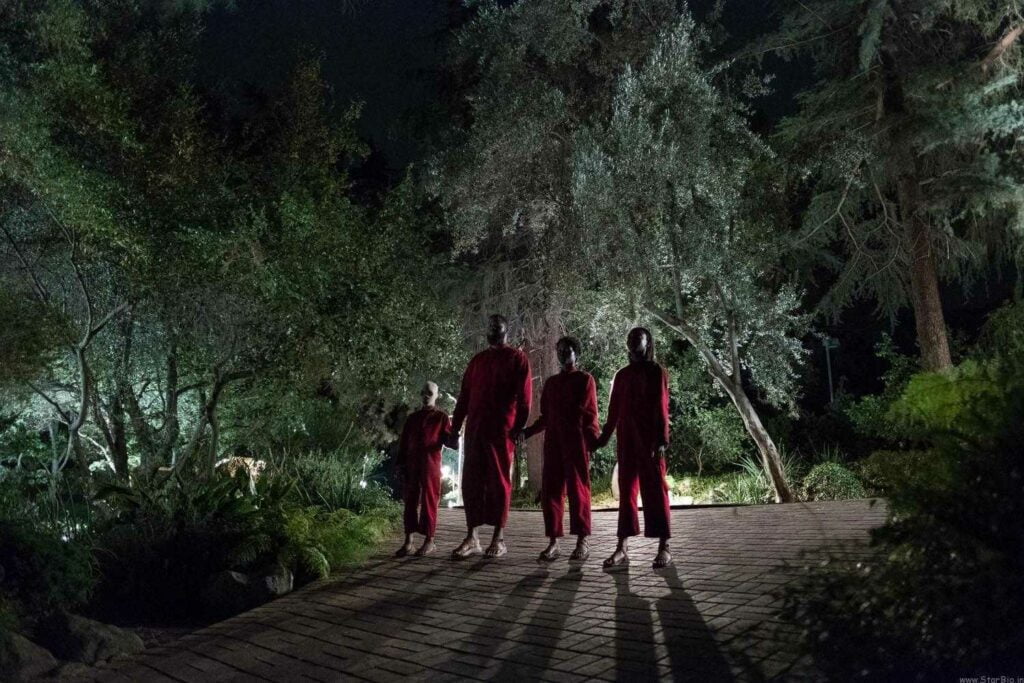Spoilers ahead for Us.
For the most part, movies are not puzzles. They may have mysterious aspects that lead to an answer, but if your movie just asking you to “solve” it, then the film dies once the movie has been “solved”. A far more interesting and lasting picture doesn’t ask for solutions, but instead looks for interpretations. When it comes to Jordan Peele’s new movie, Us, I can understand the temptation to solve how the doubles work, how they relate to the people above ground, and so forth. But these questions miss the more interesting and engaging subtext the doubles convey.
The text of the doubles is ultimately unsatisfying because it just leads to more questions. The “how” of it is pretty basic. There was a government program where everyone got a double and these doubles lived underground in tunnels. These doubles were created to control the above-ground population, although how this was supposed to happen is never explained. The doubles lived off rabbits (a food source known for its vast replication) and then the program was abandoned. They were given new purpose by “Red” (Lupita Nyong’o), who led an uprising where everyone was set to kill their double and then join hands across America, inspired by the real 1986 benefit event, “Hands Across America”.
Of course this just raises more questions. How did they feed the rabbits? Where did they get their clothes? Where did they get the scissors? And even if these questions had answers, they would be unsatisfying because the text is a (no pun intended) a rabbit hole that doesn’t lead to the more interesting aspects of the film, which is the subtext presented by the doubles.
We’re told that the doubles don’t have souls, but I don’t think it’s as simple as “everyone’s dark side”. Rather, it’s the darkness we choose to ignore. It’s not simply a matter of inverses. It’s not like sociopaths have well-rounded people wandering the tunnels. So why have it be uniform? Because it’s far more terrifying that our individuality is an illusion and that there’s nothing special about our brutality. Furthermore, if the doubles are soulless, then they can’t know individuality. However, they’re still tethered to us. Their actions are tied to ours (this isn’t explained how, and, again, any explanation would probably be unsatisfying), but they don’t get any of the benefit of our uniqueness. They live sad, hollow lives, and it’s hard to blame them for being a little stabby.
You can also look at various social reads on this. It doesn’t seem to really work as a slavery or indentured servitude metaphor because the doubles don’t produce anything and no one seems to rely on their labor. Instead, I see a parallel in how we let our dark sides out. In our interpersonal relationships, we keep things polite and cordial. But in our anonymity (keep in mind the uniformity that deny the doubles any individuality), we lash out. And just as the doubles rise and link hands across America, so too are we becoming far more comfortable with expressing hatred and violence and letting that darkness unite us (if you disagree, please check out any Internet comments section ever).
There will be those who get hung up on the “how” of Us, but the “why” is far more interesting. Additionally, while we can critique Peele for what he doesn’t do, we shouldn’t miss what he is doing. If he chooses not to paint inverse personalities for the doubles, then we should look at why he chooses to make them largely uniform with only minor variations. In Us, our dark sides are not a fully realized totality. Instead, they are a potent but fractional part of ourselves. The fear comes if we let them out and run wild.

